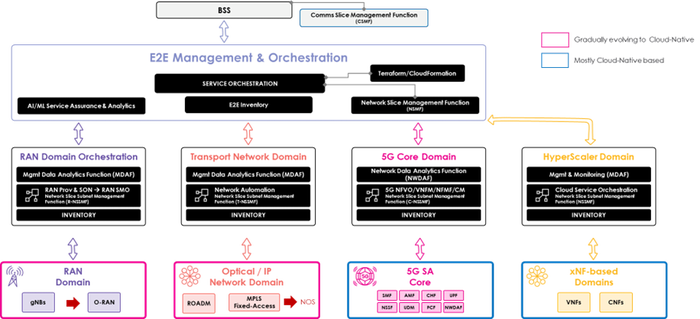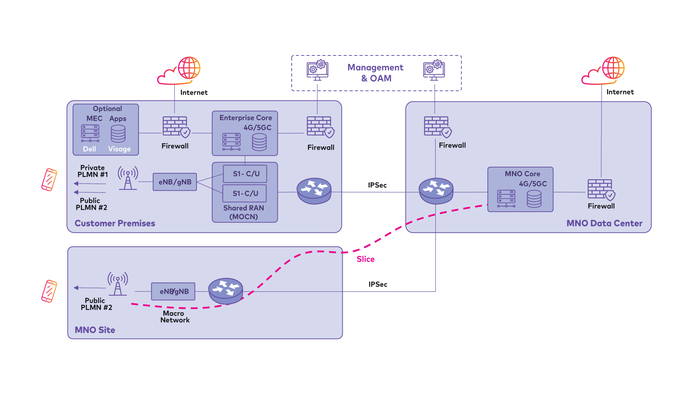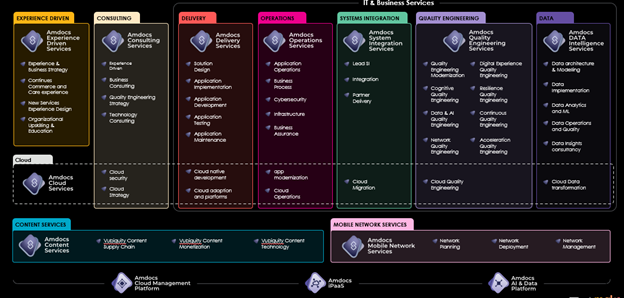Unlocking the full powers of future networksUnlocking the full powers of future networks
March 3, 2023

Sponsored Content
By Luc-Yves Pagal Vinette, Amdocs
The telecoms industry has advocated openness for 10 years. In a connected world, openness is vital for rapid, market-responsive, individualized innovation and sustainable organizational success. Opened networks make it easier for application and solution developers to innovate on CSPs/MNOs’ networks by simplifying APIs and exposure. Making software components the enrichment elements that are causing CSPs/MNOs and even organizations to design solution values that are no longer centered on physical/network assets but rather on more malleable components such as software assets accelerates and generates new monetization paths. Smart assets (data and predictive analytics, AI/ML, automation, zero-touch, and intent management) must rely on network and connection while enriching the next generation of service definitions.
As a result, it may create a truly open, collaborative industry ecosystem where partnerships prevail beyond competition, where partners across industries create a new generation of exciting opportunities, and where competitiveness means standing out by CSPs/MNOS differentiating themselves by smart capabilities in their sleeves brought by smart coding and bringing a top/down approach of services and solutions whereby business rhymes with operational capabilities. Most critically, new company models can meet changing client needs.
Let’s investigate how Amdocs Networks and openness bestow CSPs’/MNOs with new and innovative networking power.
Cloud-native and the power of infinite collaboration
In B2B or B2B2X scenarios, modern networks require a sense of service continuity across domains, both within and beyond the CSP/MNO realm. This requires the usage of a universal language based on an industry-wide consensus of tools and APIs with a consistent structure and philosophy. This cloud-native language enables endless collaboration options in our Telecoms multiverse.
Often, the meaning of “cloud-native” is misunderstood. In its true sense, it refers to hosting applications created with the fundamental principles of elasticity, automation, and observability while exploiting the capabilities of a cloud platform. The Cloud Native Computing Foundation (CNCF), a Linux Networking Foundation effort created to achieve industry-wide consensus, supports this viewpoint. Today, CNCF products including Kubernetes, Ansible, Apache Kafka, Prometheus, Grafana, and ElasticSearch, among others, provide a solid basis for exploiting the vastness of the cloud opportunity.

Fig.1: Cloud-native misalignment of technology domains
A lack of alignment between the evolution and maturity of service domains was the primary issue. The shift from 4G to 5G also caused obstacles, particularly due to the growth of the Radio Access Network (RAN). Under Open RAN, for instance, gNBs are adopting cloud-native principles, disaggregating into several software-based functions, and receiving new cloud-native management (Service Management & Orchestration) and optimization capabilities (RAN Intelligent Controller).
Cloud-native operator reluctance has been widely acknowledged and addressed. This may be due to an underestimating of the extent of the 4G-to-5G transition, which is moving us from a hardware- or virtualization-centric service architecture to a cloud-native collection of service components for 5G core, exposure, charging & control, and data analytics. When Telcos/MNOs and enterprises extend their operational or business footprints by leveraging hyperscaler infrastructure and ecosystem. It must be leveraged as per operational, business, and API standards that are consistent end-to-end, structured around cloud-native concepts and aligned with their respective OSS/BSS models and capabilities.
Cloud-native is one of the key components that enable the power of automation.
The power of automation and data analytics leads to Zero-Touch and Intent-based networks
The creation of virtualized networks based on cloud-native concepts was principally spurred by the rapid expansion of mobile devices, disaggregated functions, and the need to expedite service improvement and innovation significantly. In addition, new enabling technologies have radically transformed the perspectives of service definition and projected commercial benefits during the past few years. Notably, Artificial intelligence, Machine Learning, Deep Learning (DL) & Transfer Learning (TL), and multi-domain orchestration, which, when paired with cloud-native-based virtualization, were eventually leading to Zero-Touch networks and undoubtedly spawned Intent-based networks.
Zero-Touch networks enable CSP/MNO networks to self-heal and self-optimize without human intervention, hence reducing operational costs, increasing service flexibility, and considerably monetizing service infrastructure. AI/ML, closed-loop automation, and data analytics facilitate a challenging procedure.
Future 5G networks will incorporate MPN, network slicing, and domain-specific capabilities such as SMO (service management and orchestration) and Open RAN RIC (RAN Intelligent Controller). These systems must meet stringent time and latency requirements. Timely needs are required to transmit user-based data packets across the network and to handle faulty devices or degraded performance that require real-time or near-real-time service reconfiguration or optimization at multiple levels, such as the end-to-end solution or network slice, eventually network slice subnets or at the MEC or PNF (Physical Network Functions).
This brings up the topic of intent-based networks, where it is expected that humans require more time to study alerts/faults and determine the root cause analysis. Again, AI/ML models may play a significant role in collecting, assessing, and disseminating data service intelligence (KPIs and analytics) as well as delivering this crucial data back to the OSS platform via the closed-loop automation framework. Such data will be examined to manage both the original intent (service outcome) and the conditions of the service intent, which may need an optimization of the service or a more widespread change to the service composition.
To be successful, the power of automation must be complemented by a hyper-automation platform.
Hyperautomation activates the power of end-to-end service consistency
As most operators transition away from technology-based silos that prevented service instantiation across domains, all CSPs are rapidly migrating to end-to-end service orchestration (E2ESO) using a combination of previously discussed capabilities: cloud-native, automation, and open or closed-loop automation. With hyperscalers and B2B2X partnerships, services expand their vertical and horizontal reach as the industry evolves. The compelling characteristic of hyper-automation, particularly its capacity to instantiate services across all domains, enables enterprises to handle the increasing complexity of extended domains and partner interaction.
In the context of hyper-automation, closed-loop automation, and intent-based networks offer considerable advantages for ensuring that service composition and behavior continue to meet the original service intent and SLA criteria. Indeed, a closed-loop automation architecture enables the sharing of critical events/faults or key performance indicators (KPIs) back to the E2ESO platform based on real-time or non-real-time detection requirements. This vital data could trigger programmed measures to return the service to its initial state.
End-to-End Service Orchestration (E2ESO) or hyper-automation is the missing link required to accomplish the next generation of dedicated private network solutions.
Dedicated private networks and the power of isolation and integration
Mobile Private Networks and Network Slicing appear to provide a private and dedicated network in almost every respect, excluding how generated data will be handled and kept. It appears crucial to comprehend how a private network solution varies from a public network solution, given the industry’s growing interest in private networks. Unsecured information accessed across a shared infrastructure may be intercepted or compromised by third parties. In the context of a private network, only devices and applications authorized to connect to this network can communicate both management and user data.
Network slicing should not be confused with Mobile Private Networks since it promotes a different kind of dedicated network, whilst the actual term should emphasize the allocation of either dedicated or shared networking resources. Network slicing permits CSPs or MNOs to create cloud-native, logical network segments based on dedicated resources employing their wireline or wireless infrastructure. Depending on their configuration, each network slice and its accompanying resources may be allocated only to a single customer or shared with multiple clients.
 Fig.2: Mobile Private Networks & Network slicing example
Fig.2: Mobile Private Networks & Network slicing example
Mobile Private Networks, on the other hand, describes a network that is fully separate from the public mobile network. Mobile Private Networks are provided as a fully managed solution that is constantly monitored and supported. Private Mobile Networks may also be offered as a hybrid solution (MPN & Network slicing) in which the RAN connectivity is offered as a dedicated link or “radio slice” from the public mobile domain. MPN are typically seen as having a premium price since they provide a multitude of benefits:
On-premises network physical assets covering a particular location, site, or premises
Uses specialized spectrum for 4G/5G technologies, which can be licensed or unlicensed; 3.5 GHz CBRS is the most likely candidate
End-to-end application prioritization with dedicated bandwidth and class of service (QCI)
Utilizes specific management operating software to maintain complete control and security over their private network
The service provider and enterprise should establish a contractual SLA to ensure that the MPN meets service performance requirements (throughput, latency, availability, packet loss, and jitter)
Enables operational adaptation of the MPN solution for vertical use cases including manufacturing, airports and ports, utilities, financial utilities, logistics, and others.
Keep collected data local and securely confined to the deployment site
Inherent security and isolation to protect the solution from malware, data breaches, and DDoS attacks, but private networks already reduce risks due to their isolated nature
Isolated, but not closed, service and function exposure with dependable third-party partnerships
Ensuring that these diverse functions are aligned and made agile and adaptable enough to answer dynamic requirements originating from multiple business sectors demands increased service integration capabilities to bring everything smoothly together as per the next power.
Service Integration and the power of end-to-end togetherness
Declining ROIC (Return on Invested Capital) forces the telecom industry to reevaluate its responsibilities, where competitiveness and market distinction are now essential to ensure that investments in the most recent network technology bear fruit. From changing to user-level quality of experience (QoE), deployment speed, and customization of service business and operational capabilities to satisfy the needs of a new generation. Recent technical advances, such as multi-domain orchestration, ZT (Zero-touch) & IB (Intent-based) networks, network/service exposure, Data Analytics & AI/ML, and virtualization & cloudification of service functions backed by open-network architecture, are transforming the nature of networks. After years of falling ROI, each of these inventive streams reveals new potential for increased efficiency and the creation of new revenue streams. However, they significantly increased the complexity so that only operators could manage it.
All these trends could be managed if CSPs and MNOs have the time, resources, and knowledge that they frequently lack. It generated new questions about integrating everything seamlessly and professionally. Not only will it accelerate the transition of operators, but it will also boost their commercial capabilities in a brand-new sector of B2B, B2B2X collaboration, where the assistance and participation of hyperscalers will be essential. Service integration capabilities are a natural way to ensure that technological capabilities may be implemented as business differentiators. This covers multiple capabilities for delivering:
Consulting
Delivery
Design
Quality testing & engineering
System Integration
Operations
This would bring horizontal capabilities in cloud design and development, cloud migration, cloud and network operations, content management, and Mobile Network services.

Fig.3: Amdocs Professional services portfolio
Even if it is only one or two steps forward, integration steps are significant milestones for ensuring the success of industry players by ensuring that technology investments are aligned with business objectives and monetization. Sustaining and evolving is true of equal importance; in fact, recent network softwarization and disaggregation have never been this important. As both are advancing advancing the decoupling hardware/software act in which software control plane capabilities are anchored to an operational service platform (OSS) and standardized using open interfaces and APIs that can be used for CI/CD strategies and cloud-native tools to continuously update, enhance, and integrate new feature components.
Redefining the path forward
As a result of 5G and industry-wide collaboration, operators should reevaluate their roadmap and, so to speak, change their wireless/wireline network games, as the line dividing these two camps is increasingly thin. Rather than relying on capital-intensive investments made in the past, the market should prioritize the coverage of emerging technologies that will fundamentally affect the quality of the consumer experience. In doing so, new opportunities based on a top-to-bottom approach to BSS/OSS integration possibilities and Service integration will just become available.
Please learn more about Amdocs Networks and how to change your network game.
You May Also Like








.png?width=300&auto=webp&quality=80&disable=upscale)


_1.jpg?width=300&auto=webp&quality=80&disable=upscale)